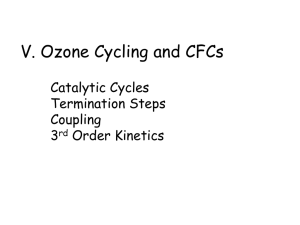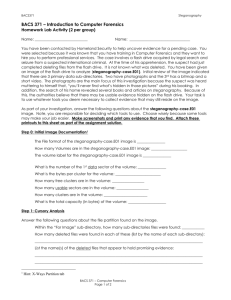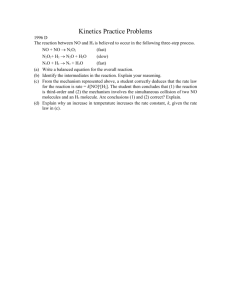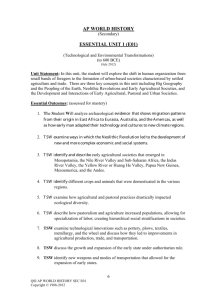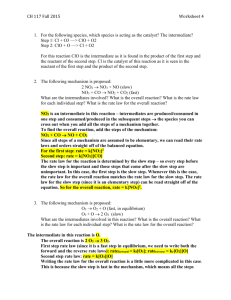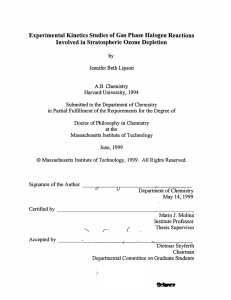IV. Kinetics Introduction (Pseudo) First Order Approx. Steady State Approximation
advertisement
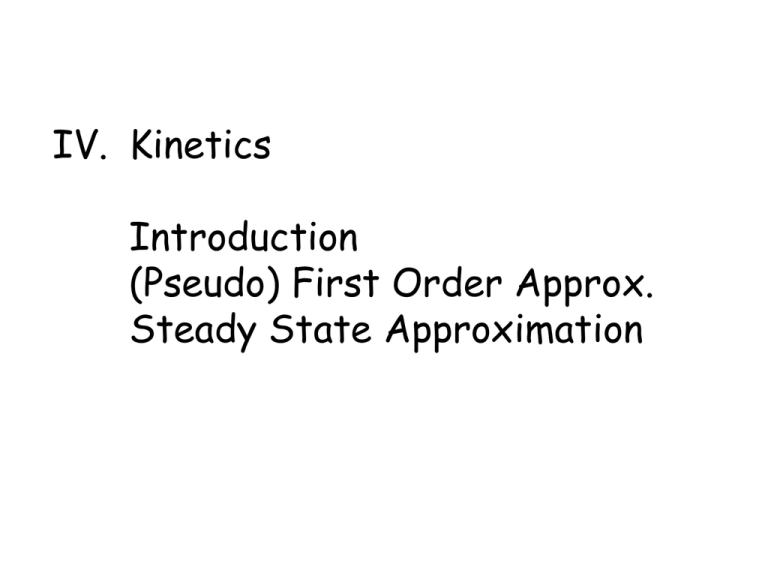
IV. Kinetics Introduction (Pseudo) First Order Approx. Steady State Approximation Role of Kinetics • Atmosphere is an open system- equilibrium does not apply • Determine chemical fate of a species • Determine concentration of a species • Compare time scales for processes – Chemical – Physical – Meteorological Simple Kinetics vs. Complex Models Simple Kinetics (here) • Approximations to give insight Complex Models • Quantitative but – Numerical solutions – Transport – Lack of insight First Order Kinetics • Photochemistry (J is 1st order rate constant) O3 + hn → O2 + O d [O3 ] J [O3 ] dt [O3 ]t [O3 ]0 e Jt Lifetime, t t = 1/J What is the photolysis lifetime of O3 at 10 km? Elementary versus Complex Reactions • Elementary – balanced reaction reflects molecular-level events (mechanism): CH4 + OH → CH3 + HOH H H . OH H H + H . H H + HOH So the Rate Law reflects the mechanism d [OH ] kCH 4OH [CH 4 ][OH ] dt • Complex – multiple elementary reactions CH4 + 2 O2 → CO2 + 2 H2O Pseudo-First Order Approximation Reduces 2nd order to 1st order [O3] >> [Cl] Major trace species vs. highly reactive radical [O3] effectively constant d [Cl ] k’ = pseudo-1st order rate constant dt kCl O 3[Cl ][O3 ] k' k Cl O 3 [O3 ] d [Cl ] k ' [Cl ] dt [Cl ]t [Cl ]0 e k 't Lifetimes and Halflife photochemistry t = 1/J Pseudo-1st order rxn. t = 1/k’ Halflife (t1/2) = 0.693 t k' k ClO3 [O3 ] kCl+O3 = 8.8 x 10-12 cm3 molecule-1 s-1 (218 K) [O3] = 5 x 1013 molecule cm-3 (25 km) What is the lifetime of Cl with respect to reaction with O3 ? Rate Constants Sources – JPL Data Evaluation, IUPAC, NIST Arrhenius (empirical) k(T) = Ae-Ea/RT A = Arrhenius pre-exponential factor Ea = activation energy For Cl + O3: k(T) = 2.9 x 10-11 e-2.2 kJ/mole/RT cm3 molecule-1 s-1 e-Ea/RT = e-(Ea/R)/T k(T) = 2.9 x 10-11 e-260/T cm3 molecule-1 s-1 What is k at 218 Kelvin ? Steady State Approximation Applied to ClO, means [ClO] changing very slowly: d [ClO ] 0 dt 1) 2) 3) 4) Cl + O3 ClO + O2 ClO + NO Cl + NO2 ClO + NO2 ClONO2 ClONO2 + hn ClO + NO2 d [ClO] k1[Cl ][O3 ] k2 [ClO][ NO] dt k3[ClO][ NO2 ] J 4 [ClONO2 ] 0 Steady State Approximation, con’t k1[Cl ][O3 ] J 4 [ClONO2 ] k2 [ClO][ NO] k3[ClO][ NO2 ] k1[Cl ][O3 ] J 4 [ClONO2 ] [ClO ]ss k 2 [ NO] k3[ NO2 ] Local noon, [radicals] at daily maximum, changing slowly Steady State Approximation okay Key Points • Pseudo-first order approximation • Steady state approximation • Data sources abound
